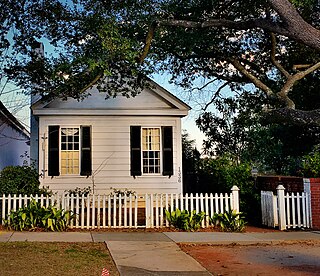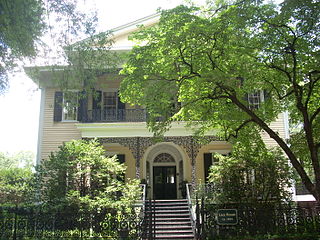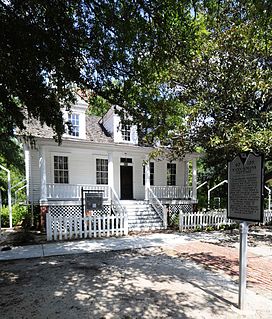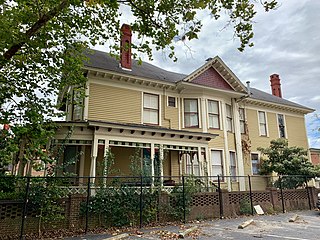
The South Carolina Supreme Court is the highest court in the U.S. state of South Carolina. The court is composed of a Chief Justice and four Associate Justices.

The Zimmerman House is a historic home located at Columbia, South Carolina, United States. It was built in 1848, and consists of a 1+1⁄2-story main section and a one-story wing. The front façade features a Greek Revival style pedimented portico supported by two paneled wooden square columns. The house was built by Charles and Hannah Zimmerman, who operated the neighboring Zimmerman School from 1848 to 1870.

The Zimmerman School is a historic school building located at Columbia, South Carolina. It was built in 1848, and is a small Greek Revival style one-story clapboard building with a gable roof. The school was built by Charles and Hannah Zimmerman, who operated it from 1848 to 1870, and also built the neighboring Zimmerman House.

Florence C. Benson Elementary School, also known as Wheeler Hill School and the Benson Building, is a historic school building for African-American students located at Columbia, South Carolina. It was built in 1953–1955 in Wheeler Hill, a segregated African-American neighborhood, as an "equalization school." The one-story, three-finger plan school, is built of concrete block with a red brick veneer and reflects influences of the Modern and International styles. The school housed 18 classrooms. The school closed in 1975.

Lace House, also known as the Robertson House, is a historic home located at Columbia, South Carolina. It was built in 1854, and is a two-story, five bay, frame dwelling on an English basement. It features a two-story, projecting front porch with ornate cast iron porch supports, and lace-like railings and trim.

Caldwell–Hampton–Boylston House is a historic home located at Columbia, South Carolina. It was built between 1820 and 1830, and is a three-story, five bay, clapboard clad frame dwelling in the Greek Revival style. It features a two-story, projecting front porch. Also on the property is contributing ironwork and brick fencing, and a stable/carriage house, garden gazebo, and tea house. In 1874–1876, it was the residence of South Carolina Reconstruction governor Daniel H. Chamberlain, who purchased the house in 1869.

Horry-Guignard House is a historic home located at Columbia, South Carolina. It was built before 1813, and is a two-story, late Federal style, modified I-house type frame dwelling. The front facade features a one-story, full-width balustraded porch supported by square columns. During the winter of 1813–1814, the main hall was widened from six feet to eleven feet. To do this, the house was sawed in half and the two ends were pulled apart to rest on two new foundations. It was probably built by Peter Horry (1747-1815), a Revolutionary War Colonel and Brigadier General of the South Carolina Militia. Later, the house was acquired by John Gabriel Guignard (1751-1822), the Surveyor General of South Carolina from 1798 to 1802. Guignard is responsible for the early design of the city and laid out the first streets of Columbia.

Mann-Simons Cottage is a historic home located at Columbia, South Carolina. It was built around 1850, and is a 1+1⁄2-story, cottage style frame house on a raised basement. The front façade features a porch supported by four Tuscan order columns. It was the antebellum home of a substantial free black Columbia family.

McCord House, also known as the McCord-Oxner House, is a historic home located at Columbia, South Carolina. It was built in 1849, and is a 1½-story clapboard Greek Revival style cottage, with additions made in the 1850s. It sits on a stuccoed raised basement. The front facade features a one-story portico supported by four stuccoed piers. It was built by David James McCord (1797–1855), a planter, lawyer, and editor, and his wife Louisa Susannah Cheves McCord, a noted author of political and economic essays, poetry, and drama. In 1865, the McCord House became the headquarters of General Oliver O. Howard, who was General William Tecumseh Sherman’s second in command. It was added to the National Register of Historic Places in 1979. The house is currently owned by Henry McMaster, the incumbent Governor of South Carolina, who purchased the property in May 2016.

Dovillers-Manning-Magoffin House, also known as the McKay House, is a historic home located at Columbia, South Carolina. It was built in 1856, and is a 1+1⁄2-story clapboard Greek Revival style cottage. It sits on a raised basement. The front facade features a one-story portico supported by four piers. It was the home of Eugene Dovilliers, an artist; the Manning family; and Dr. Ralph Deman Magoffin, a noted classical archaeologist. The house was moved to its present site in 1964.

Ensor-Keenan House is a historic home located at Columbia, South Carolina. It built about 1870, and is a 1+1⁄2-story, Italianate style frame dwelling. It features a central projecting pavilion with a steeply pitched hipped roof and full width front porch. It was the home of Dr. Joshua Fulton Ensor, second medical superintendent of the State Asylum.

W. B. Smith Whaley House, also known as the Dunbar Funeral Home, is a historic home located at Columbia, South Carolina. It built in 1892–1893, and is a three-story, irregular plan, Queen Anne style frame dwelling. It features a corner turret with conical roof and a long curving enclosed front porch. It was built by W. B. Smith Whaley, president of the Columbia Electric Street Railway and Mill Stable Company. In 1924, it became the Dunbar Funeral Home.

Moore-Mann House is a historic home located at Columbia, South Carolina. It built about 1903, and is a 2+1⁄2-story, irregular plan, Queen Anne style frame dwelling. It features a one-story verandah, bay windows, decorative shingles and an arched entrance. It was designed by W. B. Smith Whaley, Co., a prominent Columbia architectural and engineering firm, whose owner also built the W. B. Smith Whaley House.

Taylor House, also known as the former home of the Columbia Museum of Art, is a historic home located at Columbia, South Carolina. It was designed by the architectural firm of Andrews, Jacques and Rantoul and built in 1908, as a two-story, "L"-shaped, brick Neo-Classical style mansion. The front facade features a projecting portico supported by large, fluted limestone Corinthian order columns. It was built for Thomas Taylor, Jr., who served as president of Taylor Manufacturing Company.

Fair-Rutherford and Rutherford Houses, refers to a set of two historic homes located at Columbia, South Carolina. The Fair-Rutherford House was built about 1850, and underwent three alterations during the following century. It was demolished in 2004. The two-story Rutherford House was built in 1924–25. They are associated with they prominent African American Rutherford family of Columbia. The Rutherford House presently serves as an office for Palmetto Dental Services. It was added to the National Register of Historic Places in 1984.

Raymond Price House is a historic home located at Columbia, South Carolina. It was built in 1952, and is a two-story, "L"-shaped, steel-framed, masonry dwelling in the Streamline Moderne / International style. It has a flat roof and front a rear balconies. Also on the property is a one-story structure that is now an office.

Building at 303 Saluda Avenue, also known as John C. Heslep House, is a historic home located at Columbia, South Carolina. It was built about 1917 as a two-story brick residence, then remodeled and rebuilt in the Spanish Colonial Revival style in 1927–1928. It features a low-pitched tile roof, coarse stucco walls, and cast iron balconies. Also on the property is a contributing guest house.

Harden Street Substation, also known as Harden Street Fire Station, is a historic fire station located at Columbia, South Carolina. It was built in 1953, and is a two-story, rectangular brick building with a flat roof constructed in the Moderne style. It was built by the city of Columbia to house African-American firemen under white officers and maintain institutional segregation.

Columbia Central Fire Station, also known as Columbia Fire Department Headquarters and Senate Street Station, is a historic fire station located at Columbia, South Carolina. It was built between 1949 and 1951, and consists of two buildings and a structure. The main building is a two-story, rectangular, brick building in the Moderne / International Style. It has a flat roof and features horizontal bands of windows. The one-story, brick fire truck garage building and the main building were constructed in 1949–1950. The drill tower is a six-story reinforced concrete structure built in 1951. The complex served as the Columbia Fire Department's Headquarters from 1950 until 1995.

Efird's Department Store, also known as Lourie's Department Store, is a historic department store building located at Columbia, South Carolina. It was built about 1870, and is a rectangular brick building renovated and expanded in 1919. This included the addition of a third story and the installation of a new brick façade and store entrances. Between 1919 and 1958, it housed the Columbia branch of the Charlotte, North Carolina based Efird's Department Store chain. It currently houses a Mast General Store, which moved in on May 25, 2011.
























